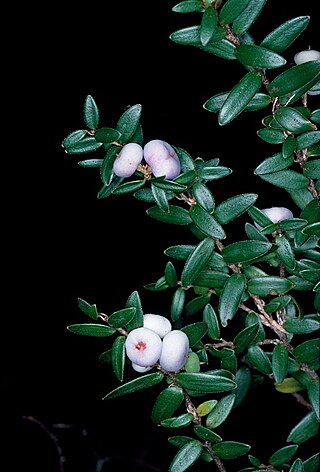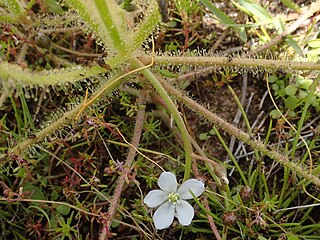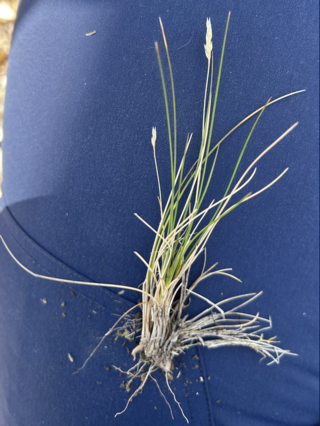
Geranium potentilloides, belongs to the family Geraniaceae, and is a small prostrate perennial herb that can grow up to 60cm high. The species is commonly referred to as Soft Cranesbill or Cinquefoil geranium.

Ampera xiphloclada, commonly known as ‘broom spurge’, is a grass-like erect shrub in the Euphorbiaceae family.

Monotoca scoparia, commonly known as prickly broom heath, is a widespread native species across south-eastern Australia. Monotoca scoparia was formerly in the family Epacridaceae but now belongs to the family Ericaceae. Monotoca is an endemic Australian genus with 17 described species occurring in all states.

Poa labillardierei, also known as common tussock-grass, is a species of tussock grass that is endemic to Australia. It is found in southern and eastern Australia, including Tasmania. There are differing variations, Poa labillardierei var. acrisVickery and Poa labillardierei var. labillardierei.

Gonocarpus montanus is a perennial, terrestrial herb in the family Haloragacae. It is native to N.S.W, Victoria, Tasmania and New Zealand. Common names include mountain raspwort and mat raspwort. Its synonym is Haloragis montana.

Trochocarpa gunnii is a species of flowering plant of the family Ericaceae and is endemic to Tasmania. It is a common, tall, rainforest understorey shrub with broadly oblong leaves and small, dense spikes of white, sometimes pink or red, glabrous flowers and purple to orange drupes.
Baumea arthrophylla(now known as Machaerina arthrophylla) is a flowering plant in the sedge family, Cyperaceae that is native to many states and territories of Australia.

Hypericum japonicum, known as matted St. John's-wort, is an annual herbaceous flowering plant in the St. John's wort family Hypericaceae, in Hypericum sect. Trigynobrathys.

Juncus antarcticus, also known as dwarf rush, is a flowering plant species in the rush family Juncaceae, native to New Zealand and Australia.

Drosera finlaysoniana is a carnivorous herb found in Australia and south east Asia. More commonly found in the north of Australia. In southern Australian sites it has been recorded at inland areas, in eucalyptus woodlands subject to flooding. Also found in Hainan, Taiwan, the Indo-China region and the Philippines.

Glycine canescens, common name Silky Glycine, is trailing or twining herb. It is a species of soybean native to Australia. A perennial living across the Outback in extremely hot and dry conditions, it is being studied for its potential to improve the cultivated soybean . Grows in sandy or stony soils in a variety of habitats.

Codonocarpus cotinifolius a tall shrub or tree in the Gyrostemonaceae family is a found in all mainland states of Australia, including Victoria, and is widespread in arid areas. It is suspected of being toxic to stock.

Westringia rigida is a shrub in the Lamiaceae family that is endemic to Australia. and
Cratystylis conocephala, the blue bush daisy, blue bush, grey bush, and round leaved greybush, is a species of flowering plant in the family Asteraceae, native to southeast Western Australia, South Australia, New South Wales, and Victoria. It is a densely branched, spreading shrub. The species is listed as endangered in New South Wales and critically endangered in Victoria.
Austrobryonia micrantha, commonly known as desert cucumber or mallee cucumber, is a species of flowering plant belonging to the family Cucurbitaceae, native to inland Australia.
Isolepis platycarpa is a small, tufted sedge species endemic to native to Australia. It belongs to the Cyperaceae family and is most commonly found coastally in Victoria and Tasmania. This rare plant is most commonly referred to as the flat-fruit club-rush.

Scleranthus fasciculatus, commonly known as spreading knawel, is a rare, spreading, non-woody herb found in the south-eastern states of Australia and introduced to New Zealand. The species is found in dry grassland habitats and requires the maintenance of inter-tussock spaces for its establishment and persistence. A number of anthropogenic factors have contributed to the species decline such as impacts from land clearing, road construction and maintenance, and herbicide application.

Poa clivicola, commonly known as fine-leaved snow grass, is an endangered Australian grass species, restricted to alpine grassy vegetation. Poa from the Greek poa (grass), clivicola- from the Latin clivus (hill) and -cola (dweller).

Lepidium phlebopetalum, commonly known as veined peppercress, is a plant of the Brassicaceae family that is endemic to parts of Australia.














